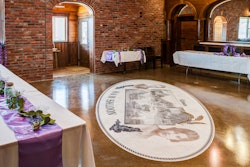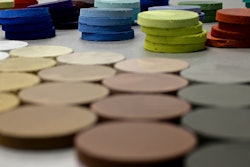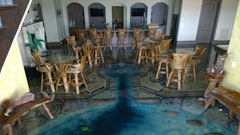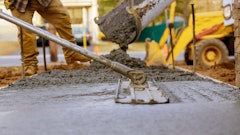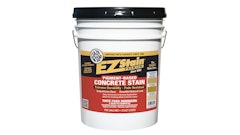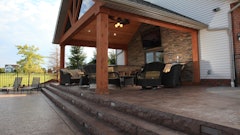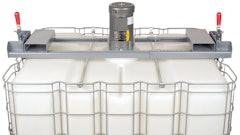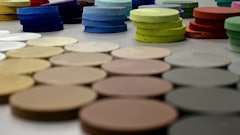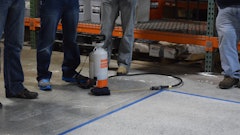
I sat down with John Reynolds, director of technical services at Solomon Colors to talk about the difference between acid- and water-based stains, common problems, and get some advice on applying stains to a slab.
Q. Does one type offer benefits over the other?
A. Water-based stains are nonreactive products. They’re more popular than acid stains in some scenarios and in other scenarios they’re not. They offer some versatility that acid stains can’t achieve like a wider variety of colors. Acid stains are limited to rust and browns (really dark browns) and then blues and greens because of the chemical nature of the stain. Water-based stains, being iron oxide pigment, have a much wider variety of color selection possibilities. Although they’re versatile, [water-based stains] can be finicky, because surface preparation is much more important with them because they have to absorb into a slab.
Acid stains are chemically reactive and basically made of hydrochloric acid, blends of metallic salts, and water. Once the hydrochloric acid breaks through the tight cream at the surface of the concrete, the metallic salts get in and react chemically with the free lime at the surface of the concrete. We’re not depositing pigment, we’re creating a chemical change…so an acid stain is only as effective as the slab’s ability to react. If you have an old slab that has a lot of sand and aggregates exposed through age—your reactivity is minimal. But, because it’s a reactive stain you have a limited selection of colors. There are only so many colors that these metallic salts can create.
That said, you’ve got limitations because greens and blues can’t be used outside. There’s a copper content in them that turn black when they come in contact with moisture.
Q. What’s the most common issue contractors run into?
A. The biggest issues that I've found over the years are surface preparation. Because a power troweled floor that's really tightly troweled is not going to allow an acid stain to get in and chemically react. [The troweling] acts as a sealer. It seals off that slab and doesn't allow the stain to get in to react. It’s the same with a water-based stain. If I have a super slick surface, I've got no way for that pigment to get in and bond. Say I clean a floor really well. I got a floor squeaky clean, but it's super tight and it's slick. I can spray on an acid stain, come back and completely wash it off. It'll look like it was never stained. Because there was no way for those salts to get in and react the way they're supposed to. Same way with a water based.
I've had jobs where the contractor did no surface preparation to open up the slab to be able to get that material to something to bond to. Surface preparation is probably the number one problem. The second biggest problem is with acid stain: neutralization and residue removal.
Q. Any advice on application?
A. There’s no pigment in [acid stain] at all—it’s totally dependent upon that slab. If you look at any manufacturer’s literature, regarding acid stain, it’s going to tell you to do a mock-up, because we don’t know how that slab is going to react to the metallic salts in the stain.
I’ve done basement floors in acid stains and I always go into the utility room or bedroom where they’re going to put carpet or something like that. I’ll put down samples for the people—that way they can see how their slab is going to react with the color that they like.
There’s surface preparation. There’s staying application. There’s residue removal process. And then there’s a sealer. All four of these things are going to change and alter the way [how the result] looks.
Without getting into a whole dissertation on surface preparation, you have to open up a slab to allow it to stick. So…we open it up with the intention of getting a chemical as well as a mechanical bond on the top of the concrete. I always tell people with acid stains, you have to prepare the surface for the sealer. Whatever sealer you're using, look in their tech data. Look and see what the surface preparation requirements are.
When I teach people about acid stain, I'm always emphasizing prep for your sealer. That said, that preparation for your sealer can alter the way the stain reacts. That's why I always recommend mockups or test samples, so that you can say, “Okay, if I'm going to sand this floor, clean it and scrub it…if I'm going to use an etching product to get a profile on the slab, that's going to alter the way my stain looks as well.” [You] got to figure all that stuff out before [you] cover up 1,000 square feet of a basement floor with acid stain.
It's not rocket science, but there's a degree of being careful. If you follow the rules, acid stains can give you beautiful, long-lasting floors. If you don't follow the rules, you can have trouble.
Generally speaking, we want to spray an acid stain down with an acid-resistant sprayer, so that you get a nice even distribution of the stain and avoid an overlap mark. As soon as that acid stain hits the concrete, it's chemically reacting. So, if I roll across a slab, and then I come back and I start rolling again, I'm going to have a line because it's reacting longer where the overlap mark is. It's doing a more intense reaction in those spots. You'll end up with this slab that looks like a roller marked mess. That's why we spray and we overlap and create a nice natural modeling with the application to a sprayer.
Q. What about clean up?
A. Once that stain chemically reacts for a minimum of four to six hours—typically, you'll leave an acid stain overnight—it brings salts to the surface. All of these salts are like a powdery residue. This is where homeowners typically freak out, “What did you do to my concrete slab?” All of this stuff comes up to the surface. Get a scrubber or [my preference] some sort of mechanical agitation of these salts so that they loosen from the surface and rinse them off.
I'll run a floor scrubber if I'm on an exterior slab with a nylon bristle brush attachment. If I'm on an interior slab, it'll be a floor scrubber with a red pad on it. You have to neutralize the slab because you're making it acidic with this muriatic acid that's in there. Neutralize it. Scrub it. Rinse it. Scrub it again and rinse it. I typically do three scrubs. The first one to neutralize and get the bulk of the acid and/or the residue off. Then, I'll do a clean water rinse. And I'll do a final clean water rinse so that I'm sure that I've got all of this residue off because if I don't have the residue off…it's going to force your sealer off the slab. Your surface preparation is important, your application technique is important, your cleaning, neutralizing residue removal process is important. And then allowing everything to dry and getting that sealer on there. All four of these things will contribute to a successful acid stain.
A lot of people will go in and mop a floor or they'll let it sit for a while and they'll just mop it—maybe throw some water on it, mop it up real quick and think they're ready for sealer. You really have to aggressively remove those salts, that residue, that comes up to the surface
Q. Does this process differ with water stain?
A. Over to water-based stain. It's extremely important to have an open slab because we're dealing with micronized iron oxide pigment. That pigment must have a place to go and grab on to. Some water-based stains have an acrylic additive in them, some don't. Either way, you must have a nice open slab for the product to get in there and cling. For example, the windshield of a car. I can spray a water-based stain on a windshield of a car and you're going to be able to wash it off because there's nothing for it to stick to. If we sandblast the windshield, and then apply the water-based stain and let it dry, then it's going to be a real bugger to get off because it's got something to stick to. Cleaning and profiling is very important with water-based stains.
Then it becomes an application technique. Typically you don't want to go over a dry surface with water-based stains because they can flash dry and you'll end up with unsightly overlap marks. By dampening the slab surface saturated-dry, (the surface is saturated with water but there's no ponding) it doesn't flash dry. [The water-based stain] has a chance to slowly penetrate into the pores of the slab.
There are two things we're looking for with water-based stain: profiling for the sealer. Whatever sealer we're putting down we want to read the tech datasheet first and figure out what it requires. The other thing is we need an open slab so that that water stain can get in and cling to the pores of the concrete without putting a layer of pigment or dust. Because once the carrier the water evaporates, you're left with iron oxide pigment, we want a nice even distribution of that pigment. We don't want concentrations of it because that's going to form that dust on the surface and going to cause the sealer to fail.
Once the water-based stain is dry, you're ready for the sealer. You don't have to clean it, you don't have to neutralize it, scrub it, or anything like that. There's advantages: many different colors and no cleaning or washing of the slab compared to acid stain.
Q. Since acid stains are limited in their color pallet, could you accent with a water stain? What if your client wants a black color?
A. You're basically doing everything with the acid stain up until the point that you're going to see. Because you can't get a true black with an acid stain due to the metallic salts, if somebody wants a really dark floor, close to black without being completely black, you can take a black water-based stain. Go through the acid-stain prep, apply the stain, let it set, do all the cleaning residue removal. Once you’re basically ready for sealer, then you can take your black stain and apply that and give it the look that you're after by enhancing the color that's down on the floor already. So, whether it's a dye or a water-based stain, it's the last thing that you're going to do to the slab when you're accenting an acid stain.
Typically, what I tell people on acid staining if you're going to do artistic work, get really familiar with how these stains react. Because blues are going to react completely different than a rusty color; it's important to be familiar with that.
I typically don't mix colors together on acid stains. I never mix different colors together. Like I won't take our Mission Brown and mix it with our Mahogany. I just won't do that. But, on the water-based stain, I'll take our Ebony and our Walnut and mix them together to create a really dark brown…it'll work because it's pigment. It's non-reactive.
Q. Will admixtures affect the color at all?
A. With acid stains, yes. With water-based stains, no - your water-based stain is going to be what it is. Now, if you have a lot of different admixtures in concrete, you can alter the color of an acid stain. Or if you have different cement contents. If I have a 7-sack mix compared to a 5-sack mix, I'm going to have a different color with an acid stain. With a water-based stain, it might be a little darker because there's more Portland cement in there that will darken when my sealer darkens everything, but you're still going to have that same general color.





